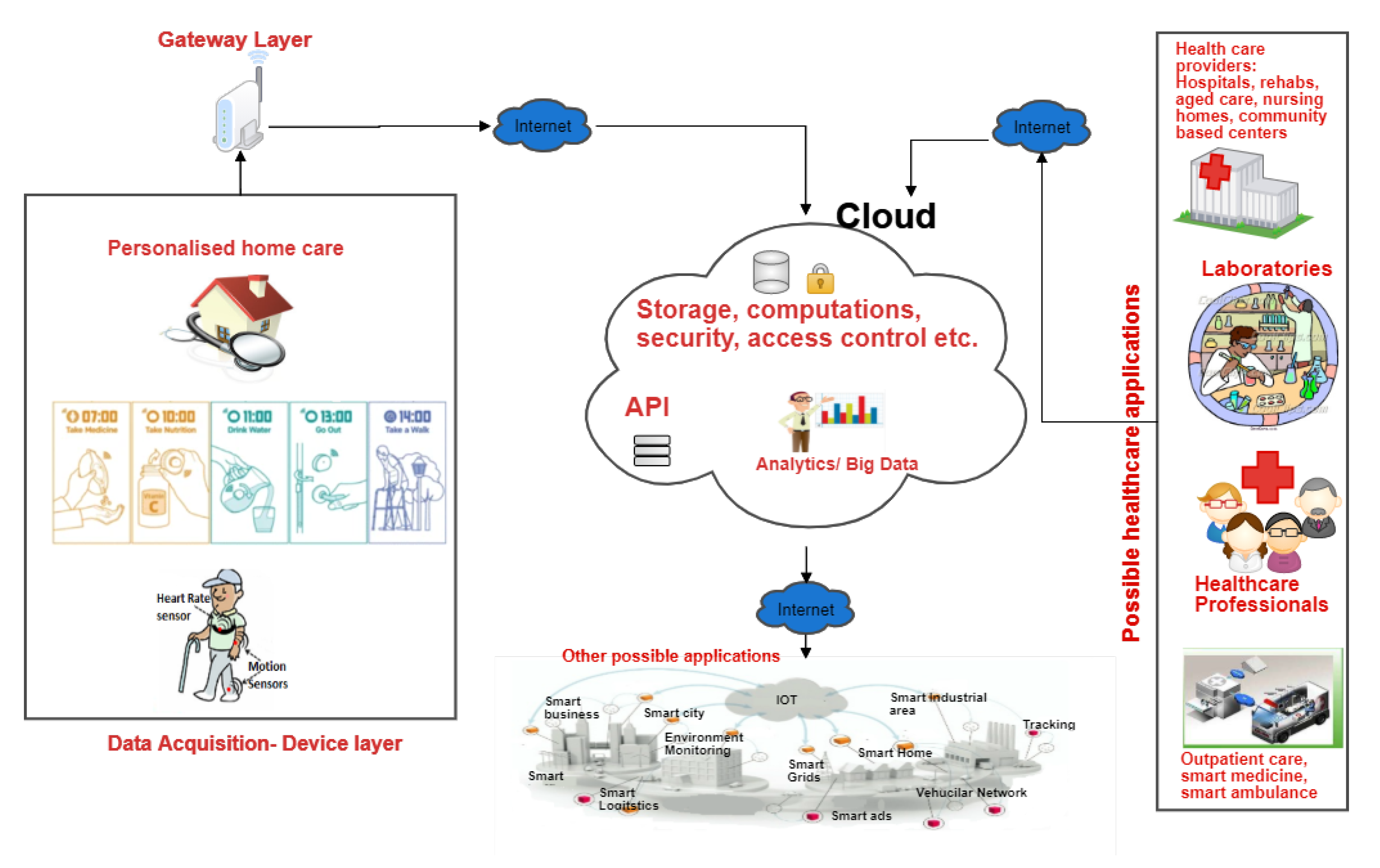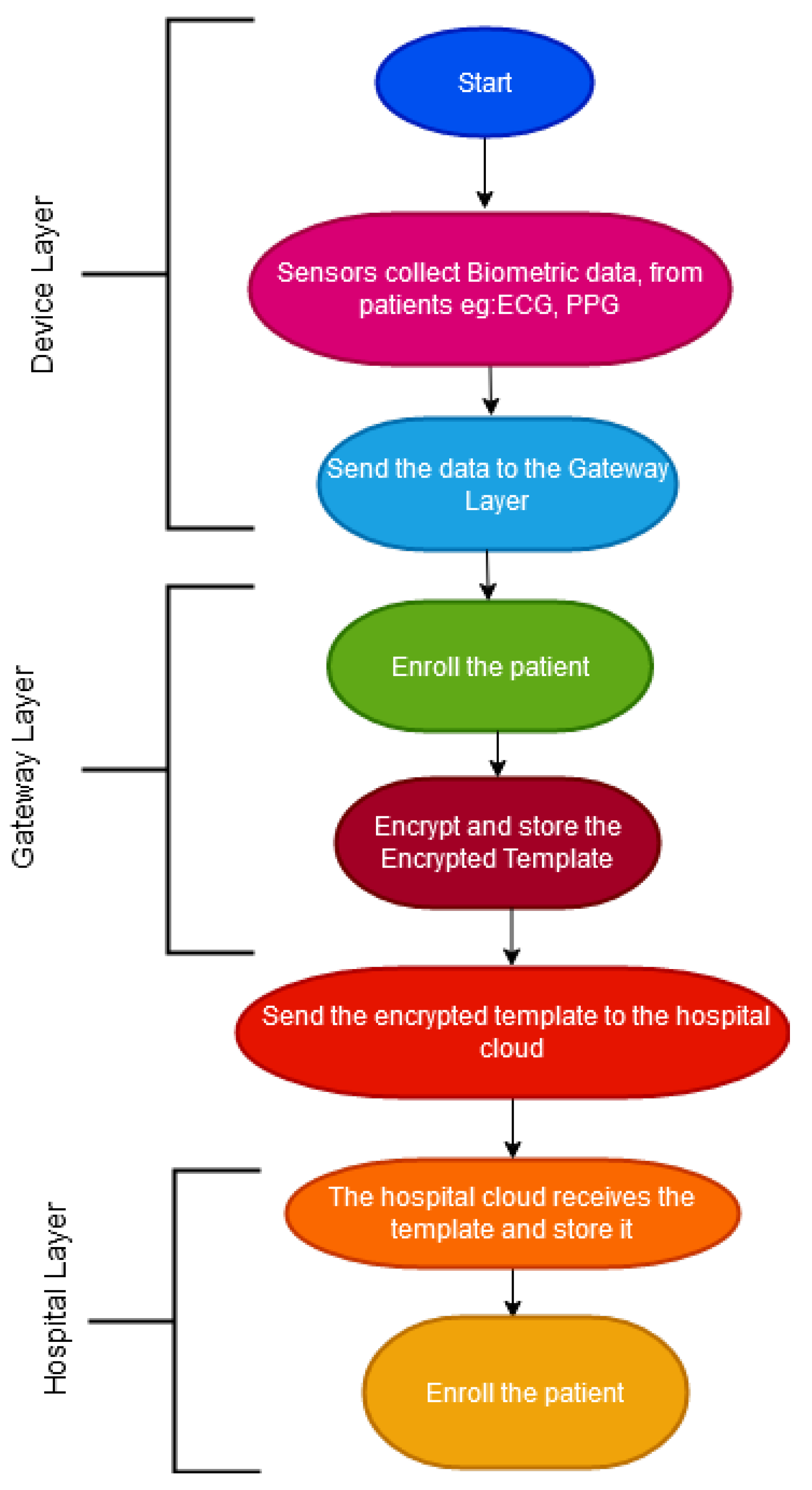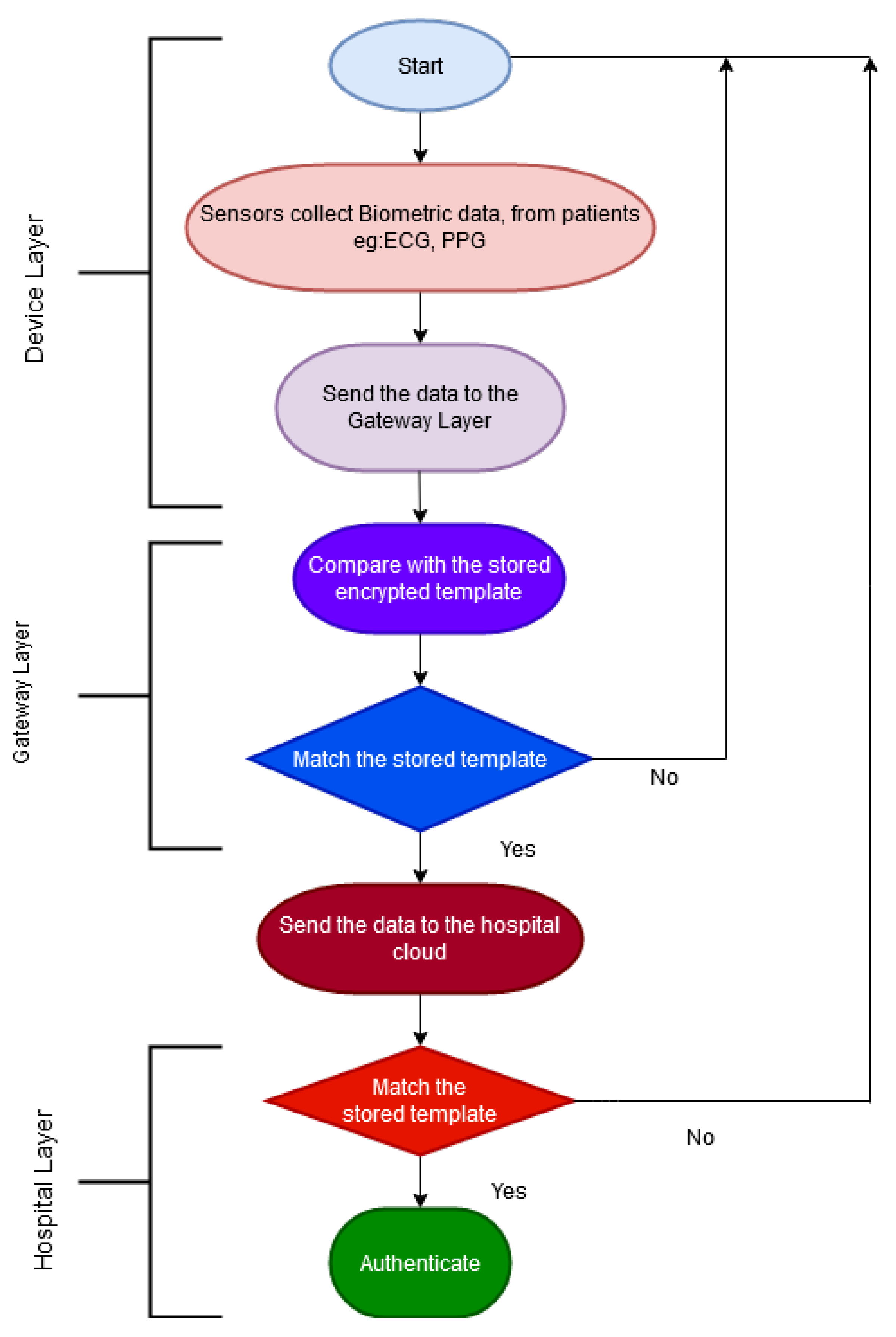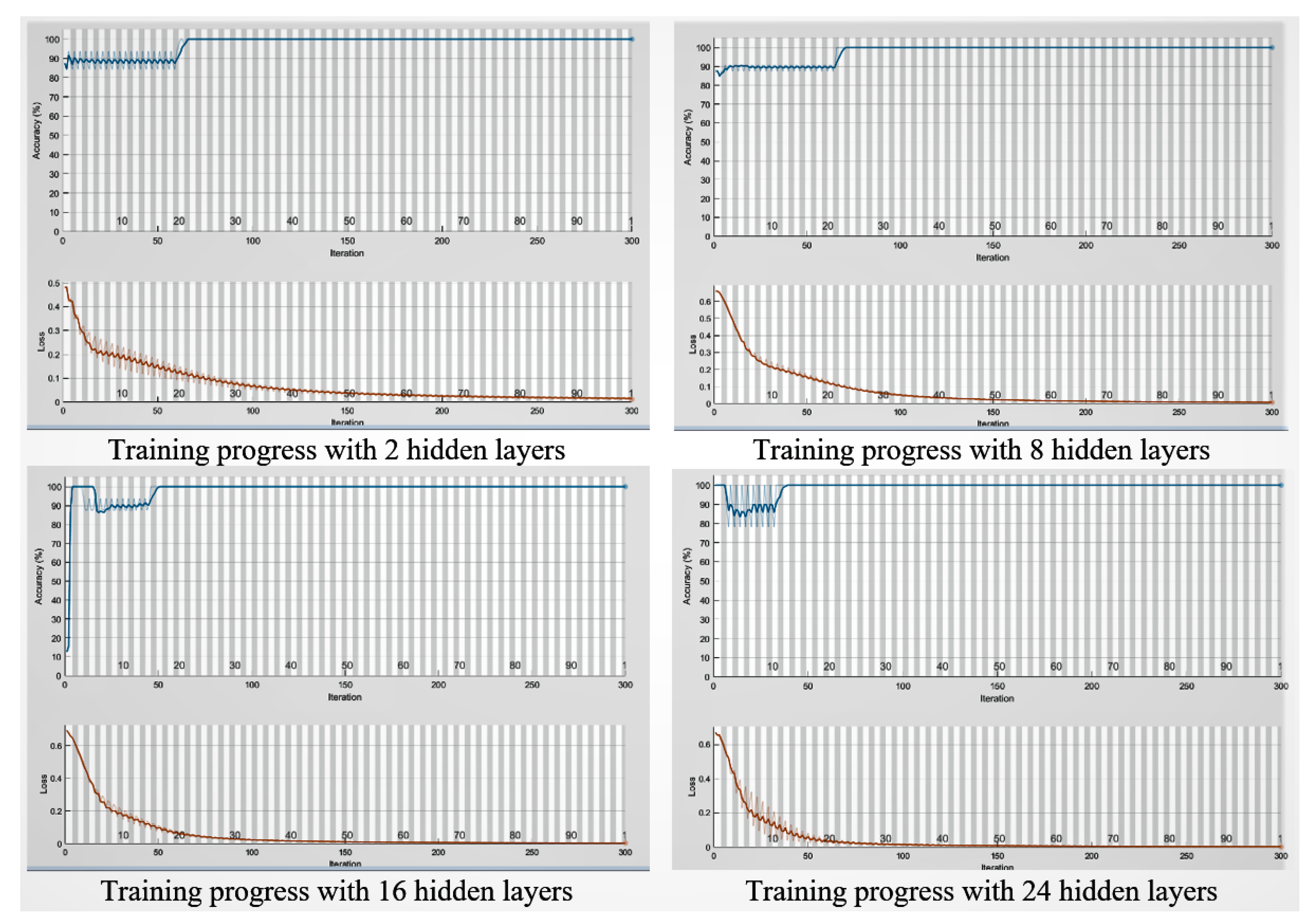A Smart Biometric Identity Management Framework for Personalised IoT and Cloud Computing-Based Healthcare Services
Abstract
1. Introduction
- The design of a novel identity management framework for IoT and cloud-based Personalised Healthcare services.
- The framework incorporates a new biometric-based authentication method. This method uses a fusion of PPG and ECG signals to uniquely identify users. Privacy is preserved using Homomorphic Encryption.
- The authentication model has been validated and tested using a fusion of ECG and PPG signals and by extracting the instantaneous frequency and spectral entropy features. The outcomes and results of the experiment were evaluated by comparing them with other similar works, which used either ECG or PPG to perform users’ authentication. It is noted that the model successfully identified all 25 users used in the experiment.
2. Background and Motivations
3. Traditional Cloud-Based IDMS Systems Challenges
4. Cloud IoT Personal Care IDMS Framework
The Authentication Framework Details
- Device Layer: The sensors collect the biometric data at various times from the patients under different settings, such as in a sitting position or when lying down and send it to the gateway layer.
- Gateway Layer: The gateway layer enrols the patient and saves the template. The biometric template is secured using the Homomorphic algorithm. The encrypted template is then sent to the hospital cloud.
- Hospital Layer: This layer stores the authentication data received from the Gateway layer to authorise the patient in the future. This layer is also responsible for computing and analysing the patient’s data.
- The patient sends new data and their biometric traits to the gateway layer through the device gateway.
- The Gateway layer tests the encrypted biometric template against the stored encrypted template in the database. If the template matches, the user is then authenticated.
- The Gateway layer sends the data to the hospital cloud. The user is then authenticated against the stored encrypted biometric template versus the newly arrived template received from the gateway. If the template matches, the user is fully authenticated.
5. Encryption for Biometric Template
- Key tuple generation: In the enrolment phase, the sensor sends the collected biometric template. The template is secured using a key pair secret key and public key . The key is generated using the ) function, which takes the biometric trait ECG/PPG as input to generate a key.
- Encryption technique: The biometric template is then encrypted using the encryption function:
- Decryption technique: The template is decrypted using the decryption function as follows:
- Evaluation function: The next function is the evaluation function Ev(,,). The evaluation function takes the generated public key from the biometric traits, circuit with m inputs, where m is the plaintext for biometric template PBioTemp and a set of CBioTemp of generated ciphertext from plaintext PBioTemp which is , , …, and output a ciphertext CBioTemp. It works in such a way that (, , …, ) = (, ) where is an allowed circuit set of biometric templates and if the ciphertext is the corresponding ciphertext for plaintext for i = 1, 2, …, m and = (, , …, ) then the evaluate function Ev(,, ) returns a ciphertext corresponding to the plaintext (, …, ) for a circuit with m inputs.
The Adversary Model
- Sample recovery attacks: In this type of attack, the perpetrator uses the spoofing or brute force technique. Consider, for example, a rogue sensor that enters the patient’s home network. To authenticate itself as a valid user, it generates an ECG and a key pair. The authentication servers, in this case the gateway layer, will enrol and will list it as a valid sensor and encrypt the template. Now the attacker will break into the real sensor and collect any data the user was sending. The attacker will directly send this data along with the ECG signal. Another key will be generated using the health data of the real patient and ECG of the impersonator. However, the encryption key will differ since the access key of the actual user is distinct. So the sample recovery attack will fail in this authentication scenario.
- Reference recovery attacks: In this case, an adversary gains access to a patient’s reference biometric traits. As in the previous scenario, the attacker also gets access to the patient’s health data. This time when the data are sent together with the real ECG signal (in the form of replay attack), the gateway layer will be tricked into providing access to data stored at the hospital cloud. To mitigate this type of attacks, in our authentication framework, we are using a signal level fusion which combines ECG and PPG signals and generates a key using these fused signals. It would be nearly impossible for the adversary to spoof both ECG and PPG of the same person.
- Concomitantly, these type of attacks can happen in the hospital cloud layer. An adversary gains access to the saved encrypted biometric template in the hospital cloud. The rogue service provider RhospCpi will try to access the data. However, data are encrypted using the Homomorphic approach, the RhospCpi will not be able to access the plaintext data and will only be able to perform computation on the data such as send it back to the patient pi. To mitigate reference recovery attacks, replay attacks and man in the middle attacks, security measures such as the use of public-key cryptography, TSL/SSL, authorised certificate authority and other classical security measures such as the use of a VPN can be incorporated in the authentication model.
6. The Experimental Work
6.1. Dataset Pre-Processing
6.2. Features Extraction
6.3. Phase One of the Experiment
The Model Training Setup
6.4. Phase Two of the Experiment
Model Training Options
7. Results and Analysis
7.1. Results: Phase 1
7.2. Results of Phase 2 of the Experiment
8. Limitations
9. Conclusions
Author Contributions
Funding
Institutional Review Board Statement
Informed Consent Statement
Data Availability Statement
Conflicts of Interest
References
- Mahajan, S. IoT. In Healthcare Market Size, Growth and Industry Trends Report 2026; Fortune Business Insights: Pune, India, 2020. [Google Scholar]
- Sultan, N. Making use of cloud computing for healthcare provision: Opportunities and challenges. Int. J. Inf. Manag. 2014, 34, 177–184. [Google Scholar] [CrossRef]
- Allscripts. Allscripts Cloud-Based EHR Solution to Support MicroHealth, LLC for Use within the United States Department of State. Available online: https://investor.allscripts.com/news-releases/news-release-details/allscripts-cloud-based-ehr-solution-support-microhealth-llc-use (accessed on 7 December 2020).
- Osman, H. The Time for Healthcare to Embrace Cloud, Is Now. Available online: https://www.healthcareit.com.au/article/time-healthcare-embrace-cloud-now (accessed on 7 December 2020).
- Garai, Á.; Péntek, I.; Adamkó, A. Revolutionizing Healthcare with IoT and Cognitive, Cloud-based Telemedicine. Acta Polytech. Hung. 2019, 16, 163–181. [Google Scholar]
- Yuan, Y.S.; Cheah, T.C. A Study of Internet of Things Enabled Healthcare Acceptance in Malaysia. J. Crit. Rev. 2020, 7. [Google Scholar] [CrossRef]
- Dang, L.M.; Piran, M.J.; Han, D.; Min, K.; Moon, H. A Survey on Internet of Things and Cloud Computing for Healthcare. Electronics 2019, 8, 768. [Google Scholar] [CrossRef]
- Ahamed, F.; Farid, F. Applying Internet of Things and Machine-Learning for Personalized Healthcare: Issues and Challenges. In Proceedings of the 2018 International Conference on Machine Learning and Data Engineering (iCMLDE), Sydney, Australia, 3–7 December 2018; pp. 19–21. [Google Scholar] [CrossRef]
- Elkhodr, M.; Shahrestani, S.; Cheung, H. Internet of Things applications: Current and future development. In Innovative Research and Applications in Next-Generation High Performance Computing; IGI Global: Hershey, PA, USA, 2016; pp. 397–427. [Google Scholar]
- Ara, A.; Ara, A. Case study: Integrating IoT, streaming analytics and machine learning to improve intelligent diabetes management system. In Proceedings of the 2017 International Conference on Energy, Communication, Data Analytics and Soft Computing (ICECDS), Chennai, India, 1–2 August 2017; pp. 3179–3182. [Google Scholar]
- Boujezza, H.; Modher, A.M.; Ayed, H.K.B.; Saidane, L. A taxonomy of identities management systems in IOT. In Proceedings of the 2015 IEEE/ACS 12th International Conference of Computer Systems and Applications (AICCSA), Marrakech, Morocco, 17–20 November 2015; pp. 1–8. [Google Scholar]
- Saha, S.; Soumitra, S. Secured Integration of IoT and Cloud Computing. Ph.D. Thesis, United International University, Dhaka, Bangladesh, 2019. [Google Scholar]
- Li, J.; Chen, X.; Huang, X.; Tang, S.; Xiang, Y.; Hassan, M.M.; Alelaiwi, A. Secure distributed deduplication systems with improved reliability. IEEE Trans. Comput. 2015, 64, 3569–3579. [Google Scholar] [CrossRef]
- Kocabaş, Ö.; Soyata, T. Medical data analytics in the cloud using homomorphic encryption. In E-Health and Telemedicine: Concepts, Methodologies, Tools, and Applications; IGI Global: Hershey, PA, USA, 2016; pp. 751–768. [Google Scholar]
- Eberz, S.; Patané, A.; Paoletti, N.; Kwiatkowska, M.; Roeschlin, M.; Martinovic, I. Broken Hearted: How to Attack ECG Biometrics. In Proceedings of the Network and Distributed System Security Symposium (NDSS) 2017, San Diego, CA, USA, 26 February–1 March 2017. [Google Scholar] [CrossRef]
- Karimian, N.; Woodard, D.; Forte, D. ECG Biometric: Spoofing and Countermeasures. IEEE Trans. Biom. Behav. Identity Sci. 2020, 2, 257–270. [Google Scholar] [CrossRef]
- Calleja, A.; Peris-Lopez, P.; Tapiador, J.E. Electrical heart signals can be monitored from the moon: Security implications for IPI-based protocols. In IFIP International Conference on Information Security Theory and Practice; Springer: Berlin/Heidelberg, Germany, 2015; pp. 36–51. [Google Scholar]
- Farid, F.; Ahamed, F. Biometric Authentication for Dementia Patients with Recurrent Neural Network. In Proceedings of the 2019 International Conference on Electrical Engineering Research & Practice (ICEERP), Sydney, Australia, 24–28 November 2019; pp. 1–6. [Google Scholar]
- Butpheng, C.; Yeh, K.H.; Xiong, H. Security and privacy in IoT-cloud-based e-health systems—A comprehensive review. Symmetry 2020, 12, 1191. [Google Scholar] [CrossRef]
- Hathaliya, J.J.; Tanwar, S.; Evans, R. Securing electronic healthcare records: A mobile-based biometric authentication approach. J. Inf. Secur. Appl. 2020, 53, 102528. [Google Scholar] [CrossRef]
- Joseph, T.; Kalaiselvan, S.; Aswathy, S.; Radhakrishnan, R.; Shamna, A. A multimodal biometric authentication scheme based on feature fusion for improving security in cloud environment. J. Ambient. Intell. Humaniz. Comput. 2020, 1–9. [Google Scholar] [CrossRef]
- Leng, L.; Li, M.; Kim, C.; Bi, X. Dual-source discrimination power analysis for multi-instance contactless palmprint recognition. Multimed. Tools Appl. 2017, 76, 333–354. [Google Scholar] [CrossRef]
- Leng, L.; Teoh, A.B.J. Alignment-free row-co-occurrence cancelable palmprint fuzzy vault. Pattern Recognit. 2015, 48, 2290–2303. [Google Scholar] [CrossRef]
- Leng, L.; Zhang, J. PalmHash Code vs. PalmPhasor Code. Neurocomput. 2013, 108, 1–12. [Google Scholar] [CrossRef]
- Leng, L.; Teoh, A.B.J.; Li, M.; Khan, M.K. A remote cancelable palmprint authentication protocol based on multi-directional two-dimensional PalmPhasor-fusion. Secur. Commun. Netw. 2014, 7, 1860–1871. [Google Scholar] [CrossRef]
- Shakil, K.A.; Zareen, F.J.; Alam, M.; Jabin, S. BAMHealthCloud: A biometric authentication and data management system for healthcare data in cloud. J. King Saud Univ. Comput. Inf. Sci. 2020, 32, 57–64. [Google Scholar] [CrossRef]
- Farooqui, M.; Gull, H.; Ilyas, M.; Iqbal, S.; Khan, M.A.; Krishna, G.; Ahmed, M. Improving Mental Healthcare Using a Human Centered Internet of Things Model and Embedding Homomorphic Encryption Scheme for Cloud Security. J. Comput. Theor. Nanosci. 2019, 16, 1806–1812. [Google Scholar] [CrossRef]
- Sharma, S.; Chen, K.; Sheth, A. Toward Practical Privacy-Preserving Analytics for IoT and Cloud-Based Healthcare Systems. IEEE Internet Comput. 2018, 22, 42–51. [Google Scholar] [CrossRef]
- Cao, Y.; Yang, L. A survey of identity management technology. In Proceedings of the 2010 IEEE International Conference on Information Theory and Information Security, Beijing, China, 17–19 December 2010; pp. 287–293. [Google Scholar]
- Bhargav-Spantzel, A.; Camenisch, J.; Gross, T.; Sommer, D. User centricity: A taxonomy and open issues. J. Comput. Secur. 2007, 15, 493–527. [Google Scholar] [CrossRef]
- Jøsang, A.; Pope, S. User centric identity management. In Proceedings of the AusCERT Asia Pacific Information Technology Security Conference, Manila, Philippines, 21–24 April 2005; p. 77. [Google Scholar]
- Gemmill, J.; Robinson, J.P.; Scavo, T.; Bangalore, P. Cross-domain authorization for federated virtual organizations using the myVocs collaboration environment. Concurr. Comput. Pract. Exp. 2009, 21, 509–532. [Google Scholar] [CrossRef]
- Domenech, M.C.; Comunello, E.; Wangham, M.S. Identity management in e-Health: A case study of web of things application using OpenID connect. In Proceedings of the 2014 IEEE 16th International Conference on e-Health Networking, Applications and Services (Healthcom), Natal, Brazil, 15–18 October 2014; pp. 219–224. [Google Scholar]
- Xiao, Y.; Chen, X.; Li, W.; Liu, B.; Fang, D.; Li, W. An immune theory based health monitoring and risk evaluation of earthen sites with Internet of Things. In Proceedings of the 2013 IEEE International Conference on Green Computing and Communications and IEEE Internet of Things and IEEE Cyber, Physical and Social Computing, Beijing, China, 20–23 August 2013; pp. 378–382. [Google Scholar]
- Arias-Cabarcos, P.; Almenárez-Mendoza, F.; Marín-López, A.; Díaz-Sánchez, D.; Sánchez-Guerrero, R. A metric-based approach to assess risk for “on cloud” federated identity management. J. Netw. Syst. Manag. 2012, 20, 513–533. [Google Scholar] [CrossRef]
- Sánchez, R.; Almenares, F.; Arias, P.; Díaz-Sánchez, D.; Marin, A. Enhancing privacy and dynamic federation in IdM for consumer cloud computing. IEEE Trans. Consum. Electron. 2012, 58, 95–103. [Google Scholar] [CrossRef]
- Jam, M. System and Method for Providing Context-Aware Computer Management Using Smart Identification Badges. U.S. Patent 8,069,157, 29 November 2011. [Google Scholar]
- Conrado, C.; Kamperman, F.; Schrijen, G.J.; Jonker, W. Privacy in an Identity-based DRM System. In Proceedings of the 14th International Workshop on Database and Expert Systems Applications, Prague, Czech Republic, 1–5 September 2003; pp. 389–395. [Google Scholar]
- Doukas, C.; Maglogiannis, I. Bringing IoT and Cloud Computing towards Pervasive Healthcare. In Proceedings of the 2012 Sixth International Conference on Innovative Mobile and Internet Services in Ubiquitous Computing, Palermo, Italy, 4–6 July 2012; pp. 922–926. [Google Scholar] [CrossRef]
- Bala, Y.; Malik, A. Biometric inspired homomorphic encryption algorithm for secured cloud computing. In Nature Inspired Computing; Springer: Berlin/Heidelberg, Germany, 2018; pp. 13–21. [Google Scholar]
- Pagnin, E.; Mitrokotsa, A. Privacy-preserving biometric authentication: Challenges and directions. Secur. Commun. Netw. 2017, 2017, 7129505. [Google Scholar] [CrossRef]
- Blasco, J.; Peris-Lopez, P. On the feasibility of low-cost wearable sensors for multi-modal biometric verification. Sensors 2018, 18, 2782. [Google Scholar] [CrossRef] [PubMed]
- Ahamed, F. BioMetric Identification Using Fusion of PPG and ECG. 2020. Available online: https://github.com/fsumon/BioFusion1 (accessed on 20 December 2020).
- Boashash, B. Estimating and interpreting the instantaneous frequency of a signal. I. Fundamentals. Proc. IEEE 1992, 80, 520–538. [Google Scholar] [CrossRef]
- Pan, Y.; Chen, J.; Li, X. Spectral entropy: A complementary index for rolling element bearing performance degradation assessment. Proc. Inst. Mech. Eng. Part C J. Mech. Eng. Sci. 2009, 223, 1223–1231. [Google Scholar] [CrossRef]
- Singh, Y.N.; Singh, S.K.; Gupta, P. Fusion of electrocardiogram with unobtrusive biometrics: An efficient individual authentication system. Pattern Recognit. Lett. 2012, 33, 1932–1941. [Google Scholar] [CrossRef]
- Derawi, M. Wireless chest-based ECG biometrics. In Computer Science and its Applications; Springer: Berlin/Heidelberg, Germany, 2015; pp. 567–579. [Google Scholar]









| Notation | Description |
|---|---|
| p | Patient i |
| h | Health worker i |
| GCp | Gateway Layer i |
| hospCp | Hospital Service Cloud Provider i |
| RhospCp | Rough Service Provider i |
| Size of LSTM | TN | FN | FP | TP | Sensitivity | Specificity | Precision | Accuracy | F Score |
|---|---|---|---|---|---|---|---|---|---|
| 2 Layers | 107 | 0 | 0 | 72 | 100.00% | 100.00% | 100.00% | 100.00% | 100.00% |
| 8 Layers | 108 | 0 | 0 | 71 | 100.00% | 100.00% | 100.00% | 100.00% | 100.00% |
| 16 Layers | 108 | 0 | 0 | 71 | 100.00% | 100.00% | 100.00% | 100.00% | 100.00% |
| 24 Layers | 107 | 0 | 0 | 72 | 100.00% | 100.00% | 100.00% | 100.00% | 100.00% |
| Size of BiLSTM | TN | FN | FP | TP | Sensitivity | Specificity | Precision | Accuracy | F Score |
|---|---|---|---|---|---|---|---|---|---|
| 2 Layers | 46 | 0 | 0 | 30 | 100.00% | 100.00% | 100.00% | 100.00% | 100.00% |
| 8 Layers | 45 | 0 | 0 | 31 | 100.00% | 100.00% | 100.00% | 100.00% | 100.00% |
| 16 Layers | 45 | 0 | 0 | 31 | 100.00% | 100.00% | 100.00% | 100.00% | 100.00% |
| 24 Layers | 46 | 0 | 0 | 32 | 100.00% | 100.00% | 100.00% | 100.00% | 100.00% |
Publisher’s Note: MDPI stays neutral with regard to jurisdictional claims in published maps and institutional affiliations. |
© 2021 by the authors. Licensee MDPI, Basel, Switzerland. This article is an open access article distributed under the terms and conditions of the Creative Commons Attribution (CC BY) license (http://creativecommons.org/licenses/by/4.0/).
Share and Cite
Farid, F.; Elkhodr, M.; Sabrina, F.; Ahamed, F.; Gide, E. A Smart Biometric Identity Management Framework for Personalised IoT and Cloud Computing-Based Healthcare Services. Sensors 2021, 21, 552. https://doi.org/10.3390/s21020552
Farid F, Elkhodr M, Sabrina F, Ahamed F, Gide E. A Smart Biometric Identity Management Framework for Personalised IoT and Cloud Computing-Based Healthcare Services. Sensors. 2021; 21(2):552. https://doi.org/10.3390/s21020552
Chicago/Turabian StyleFarid, Farnaz, Mahmoud Elkhodr, Fariza Sabrina, Farhad Ahamed, and Ergun Gide. 2021. "A Smart Biometric Identity Management Framework for Personalised IoT and Cloud Computing-Based Healthcare Services" Sensors 21, no. 2: 552. https://doi.org/10.3390/s21020552
APA StyleFarid, F., Elkhodr, M., Sabrina, F., Ahamed, F., & Gide, E. (2021). A Smart Biometric Identity Management Framework for Personalised IoT and Cloud Computing-Based Healthcare Services. Sensors, 21(2), 552. https://doi.org/10.3390/s21020552





